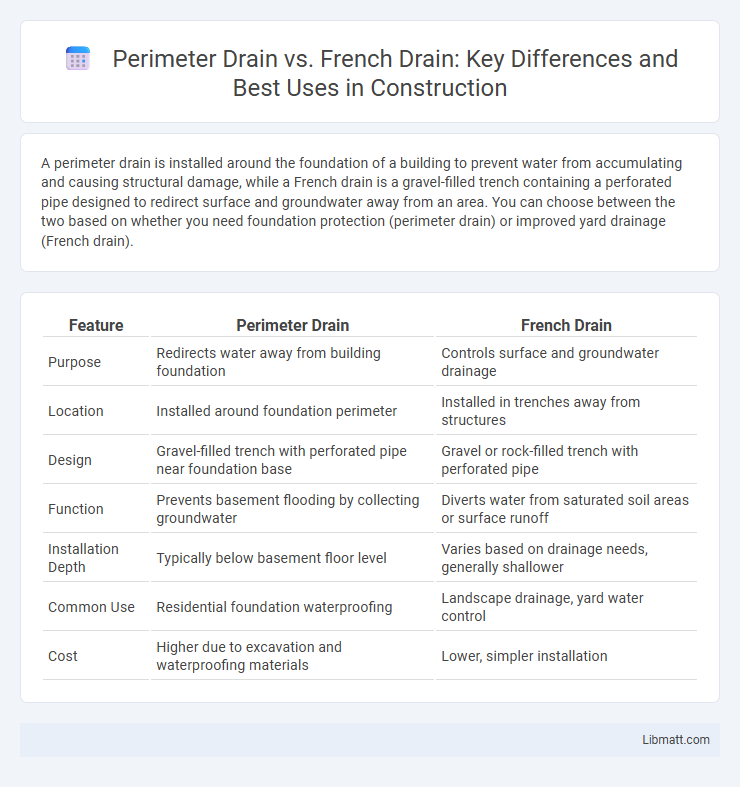A perimeter drain is installed around the foundation of a building to prevent water from accumulating and causing structural damage, while a French drain is a gravel-filled trench containing a perforated pipe designed to redirect surface and groundwater away from an area. You can choose between the two based on whether you need foundation protection (perimeter drain) or improved yard drainage (French drain).
Table of Comparison
| Feature | Perimeter Drain | French Drain |
|---|---|---|
| Purpose | Redirects water away from building foundation | Controls surface and groundwater drainage |
| Location | Installed around foundation perimeter | Installed in trenches away from structures |
| Design | Gravel-filled trench with perforated pipe near foundation base | Gravel or rock-filled trench with perforated pipe |
| Function | Prevents basement flooding by collecting groundwater | Diverts water from saturated soil areas or surface runoff |
| Installation Depth | Typically below basement floor level | Varies based on drainage needs, generally shallower |
| Common Use | Residential foundation waterproofing | Landscape drainage, yard water control |
| Cost | Higher due to excavation and waterproofing materials | Lower, simpler installation |
Understanding Perimeter Drains: Definition and Purpose
A perimeter drain is a drainage system installed around the foundation of a building to prevent water accumulation and protect against basement flooding. Its primary purpose is to redirect groundwater away from the structure, reducing hydrostatic pressure on foundation walls. Understanding your perimeter drain's role helps maintain a dry and stable foundation, safeguarding your property from water damage.
What Is a French Drain? Key Features Explained
A French drain is a trench filled with gravel or rock containing a perforated pipe designed to redirect surface water and groundwater away from an area. Key features include its ability to prevent water accumulation near foundations, reduce soil erosion, and improve drainage in wet or marshy areas. Unlike perimeter drains that primarily protect building foundations, French drains are versatile for landscape drainage and managing water flow in various locations.
Differences Between Perimeter Drains and French Drains
Perimeter drains are installed around the foundation of a building to prevent water from seeping into basements, directing excess water away from the structure. French drains consist of a trench filled with gravel and a perforated pipe designed to redirect surface and groundwater away from an area, typically used to alleviate yard drainage issues. Understanding these differences helps you choose the right system for effective water management tailored to your property's needs.
Common Applications for Perimeter Drains
Perimeter drains are commonly used around foundations and basements to prevent water accumulation and flooding by redirecting groundwater away from structures. These systems are essential in areas with high water tables or poor soil drainage, effectively protecting building stability and interior spaces from moisture damage. Perimeter drains are often installed in residential and commercial buildings, especially in regions prone to heavy rainfall or snowmelt.
Where French Drains Work Best
French drains work best in areas with poor surface drainage or where groundwater tends to accumulate near foundations, such as around basements or in yards with heavy clay soil. They effectively redirect water away from problem spots by using a perforated pipe surrounded by gravel, allowing efficient subsurface water collection and dispersal. Unlike perimeter drains that are primarily installed around building foundations for structural protection, French drains excel in managing general landscape drainage issues and preventing water pooling in low-lying areas.
Pros and Cons of Perimeter Drains
Perimeter drains effectively prevent water intrusion by channeling water away from your foundation, reducing basement flooding and soil erosion. They require professional installation and regular maintenance to avoid clogs and potential pipe damage, which can increase overall costs. While perimeter drains excel in managing water at the foundation level, they may not be suitable for all soil types or landscapes compared to more versatile options like French drains.
Advantages and Disadvantages of French Drains
French drains offer superior water management by efficiently redirecting surface and groundwater away from your home's foundation, reducing the risk of basement flooding and soil erosion. Their perforated pipe design combined with gravel facilitates optimal drainage and prevents water buildup, but installation can be labor-intensive and costly compared to perimeter drains. While perimeter drains focus primarily on foundation protection, French drains provide versatile, broader drainage solutions, though they may require regular maintenance to prevent clogging and ensure long-term effectiveness.
Cost Comparison: Perimeter Drain vs French Drain
Perimeter drains typically cost between $5 to $15 per linear foot, while French drains average $20 to $30 per linear foot due to additional materials like gravel and piping. Installation complexity and site conditions can significantly influence the overall expense of both drainage systems. Homeowners should weigh long-term benefits against upfront costs when choosing between a perimeter drain or a French drain for effective water management.
Installation Process: Perimeter Drain vs French Drain
The installation process for a perimeter drain involves digging a trench around the foundation of a building to redirect water away, typically using perforated pipes surrounded by gravel to facilitate drainage. In contrast, a French drain is installed by creating a trench filled with gravel and a perforated pipe that collects and channels surface water or groundwater away from an area, often used in landscaping or yard drainage. Your choice depends on whether you need foundation protection with perimeter drains or broader landscape water management with French drains.
Choosing the Right Drainage System for Your Property
Perimeter drains are installed around the foundation to prevent water seepage and protect your property's structural integrity, making them ideal for continuous water exposure. French drains consist of a trench filled with gravel and a perforated pipe, designed to redirect surface and groundwater away from problem areas, suitable for managing localized water accumulation. Selecting the right drainage system depends on your property's terrain, water drainage needs, and whether the goal is foundation protection or surface water management.
Perimeter drain vs French drain Infographic

 libmatt.com
libmatt.com